#imagining maria sibylla
Text
Insect predators and parasites
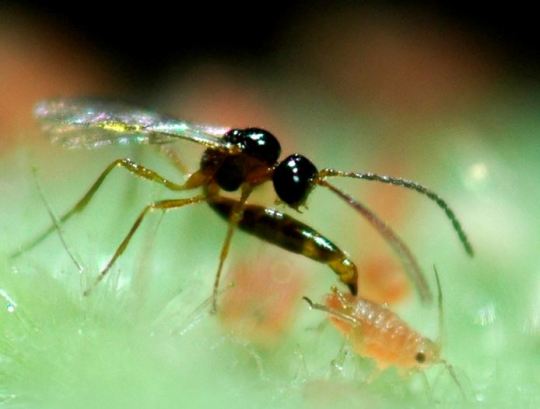
Insect predators and parasites are legion, and undoubtedly active in your garden right now, attacking and killing unwanted visitors,
and you rarely know it. It’s a “bug-eat-bug” world. Remember, for every insect that has ever plagued your flowers, vegetables, or fruit, there exists at least one natural enemy, usually several.
Predation is straightforward. A predator kills and eats many individuals over the course of its life. Also it is usually bigger, not smaller, than its intended prey. Avoiding predation is a strong force in nature, specifically in natural selection. Many insects have evolved defenses against predators. For example, velvet “ants,” actually hunting wasps, touched on in the previous chapter, squeak using a “stridulatory” organ, have a painful sting, display a warning coloring (a characteristic known as aposematism), have an alarm secretion, and have a very hard exoskeleton—not exactly the most appetizing prospect. The predators, in turn, respond to the new selection pressure, and we’re off to the races! Those velvet ants have won their particular race. It is a rarity, but no predators are willing to tangle with them.
The biology of parasitism is more complex. Maria Sibylla Merian, an early naturalist and artist (1647–1717), observed her subjects closely, particularly caterpillars and the plants on which they feed. Well ahead of her time, she was one of the first to record the existence of parasitoids. Many of her paintings beautifully illustrate the complexity of the food web, depicting not only a plant, but
also the associated insects in all stages of development. More prosaically (or graphically!), insect predation and parasitism has been inspirational in science fiction—witness for example Ridley Scott’s classic 1979 film Alien.
Before we go any further, let’s clarify the difference between a parasite and a parasitoid. A parasite lives on or inside a host, and is usually far smaller.
Although it may move from host to host, it very rarely kills its comfortableabode. Indeed, parasites are often bound to their host for life. In contrast, a parasitoid may be much larger than a parasite. A parasitoid also lives on or inside a host, but only for part of its life cycle, with a free-living adult stage. Those that develop within their insect host are endoparasitoids; ectoparasitoids develop externally to their host. Parasitoids almost invariably kill their host.
Some insects simply act as parasites on other animals. For example, the infamous bot flies, which parasitize mammals in the flesh or digestive tract, cause discomfort at best and infection and even death at worst. Parasitism in insects themselves is often overlooked. This is partly because the hosts may appear healthy to the casual observer, and partly because the creature doing the damage is so small or out of sight. One parasite we do notice is the varroa mites that plague honey bee colonies. Some parasitoids pupate externally, but many drop to the ground. Others complete their life cycle inside the host’s body, emerging only once they reach their adult stage. In this chapter, we will examine flies and wasps that operate in these ways in our gardens.
If all you know of flies is chasing house flies with a swatter, it is time to take a closer look at the flies in your garden. There is more variety in the order Diptera than most people imagine. Among them are a number of predaceous and parasitic species. We were introduced to the hover flies (predators) and the tachinid flies (endoparasitoids) in the previous chapter on flower visitors.
In the amazingly diverse and large insect order Hymenoptera (which
includes wasps, bees, and ants), it is the wasps that play a principal role as parasitoids. When most people hear the word “wasp,” some sort of pesky insect comes to mind, such as the yellow jackets that harass us at a picnic or the paper wasps that dangle a threateningly large nest over a doorway. Despite the fact that my dad was a parasitologist (he specialized in tropical diseases), it was only
later, in a college entomology class, that I was introduced to the Parasitica, the parasitic Hymenoptera, so rich in wonderful adaptations. With over 89,000 species worldwide (over 60 percent of all wasp species), I was hooked! The most common parasitoid wasps in gardens include the braconids, the ichneumonids,
and several families of chalcids. It is a powerful trio, essential to our ecosystems.
0 notes
Text
Backstage of a flowery catwalk.
For the Italian translation click on the link.
Every beginning is like a promise. An ideal gift wrapped into a decorative paper. There is a vision at the horizon, a blooming picture full of magic in order to reach an important aim one is concerned about. I remember Lawrence Ferlinghetti’s wild dreams about a new beginning: “Eyes smell flowers and become them….” His poems accompanied me on my journeys and I still love to recite his verses, in a loud voice.

The Promise. Silvia Zambarbieri’s works rolled in. Entrance of the Garden Serre Torrigiani, Florence.
So it was with Silvia Zambarbieri and the difficult beginning of her textile exhibition in homage to English 18th century’s botanist Anna Atkins. What my alter ego and dearest friend, Curator Elisabeth Vermeer, had on her mind for the setting at the Serre Torrigiani in Florence, and not only there, was a scenography of giant flowers growing on the hedges, coming down from tree branches, lying on the meadows, hanging on the wall of the Greenhouse. When our fashion artist approached the venue for the first time, she brought a textile roll under her arm, tied with a ribbon in cotton. The roll hid the story of her most intimate garden. Nobody could imagine how it would end up. Again with Ferlinghetti’s words: “Lives cross lives.”

Silvia Zambarbieri, “Magnolia” patchwork in various materials with embroidered pistils put into evidence.
Elisabeth Vermeer divided the exhibition into various little gardens. The mission of the invited artists was a confrontation with nowadays nature and the consequences of the climate change on nature’s health. Silvia Zambarbieri’s objective was using the art of botany drawing of the past centuries and transforming the images into three dimensional works in textile fabric. Moreover, in her everyday life she actively stands up for the planets safeguard insisting on research, on the processing of natural materials and on the ecological sustainability of fashion design and of her own creations she makes a living with, bags, dresses, shirts, jackets and objects for the home.
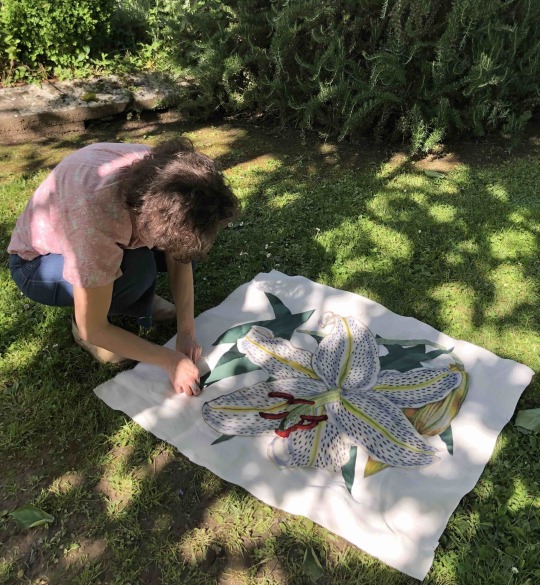
Silvia Zambarbieri fixes the giant lily’s green leaves on the cloth.

Another version of a Magnolia in the grass. Botanical illustration.
The calm atmosphere of a sunny lazy Saturday afternoon in May allowed the observation of the surrounding nature but also the recall of the memory of botanical illustration. Where does it come from ? Prior to the invention of photography, botanical illustration was the only way of visually recording the world’s many species of plant life. Artists and illustrators shared the beauty of botany with the world. Their work required great artistic skill, attention to fine detail, and technical horticultural knowledge. This is the point where we can reach out to botanist Anna Atkins who was the first woman to produce a photography book on her magnificent cyanotype impressions of algae, ferns, poppies, blades of grass, anatomised leaves.
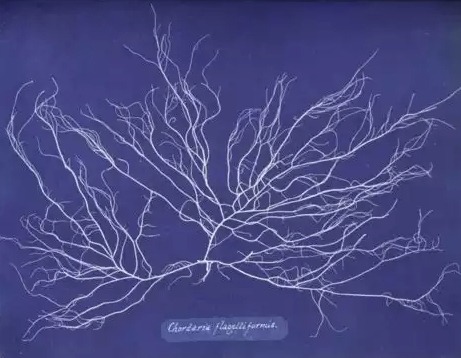
Anna Atkins, Cyanotype of Ocean Flowers
Silvia Zambarbieri pays homage to plant life in a contemporary way by studying the morphology and the gracious appearance of the plants. Beyond her favourite illustrator Pierre-Josephe Redouté there were many other extraordinary botany artists in the course of the last centuries like Maria Sibylla Merian, the Bauer Brothers, Anne Pratt, Marianne North, Ernst Haeckel, Rory McEven, Pandora Seelars, maybe one of the most important botanical artists of all time. At the moment Zambarbieri’s recurrent botanical subjects are lilies, waterlilies, irises, magnolia, roses and tulips.

Giant Lily set on framed paper. Wall of the Historical Greenhouse, Serre Torrigiani, Florence. Pierre-Joseph Redouté, etching of a lily.

Pattern of the Red Giant Lily lying in the grass. Pierre-Joseph Redouté, Fleur-de-Lys of Saint Jacques.
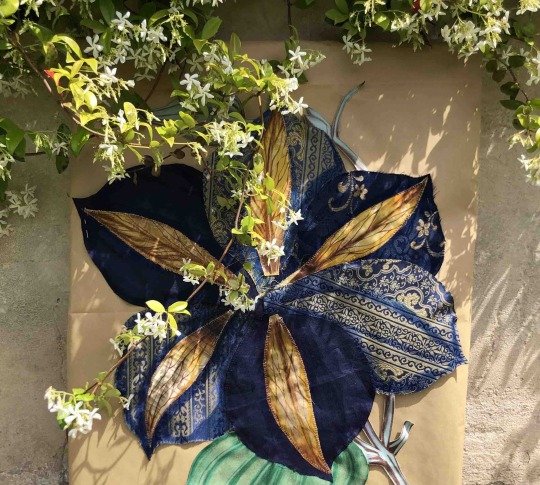
Blue Giant Lily created with various materials in Zambarbieri’s typical patchwork technique. Setting on framed paper. Wall of the Historical Greenhouse, Serre Torrigiani, May 2021.
Zambarbieri’s recent occupation is the eco-printing of authentic blossoms, petals and leaves on cloth to create natural impressions on her dresses. The aspect and the shape of the prints are enriched and completed by drawing, painting and embroidery. English poet Robert Graves writes “in the beginning was a word”. In curator Elisabeth Vermeer’s life “in the beginning was a flower, simple, as simple as it seemed.” This is what she tries to hand over to all her artists and above all to who works with the heritage of botany, like Silvia Zambarbieri.
0 notes
Text


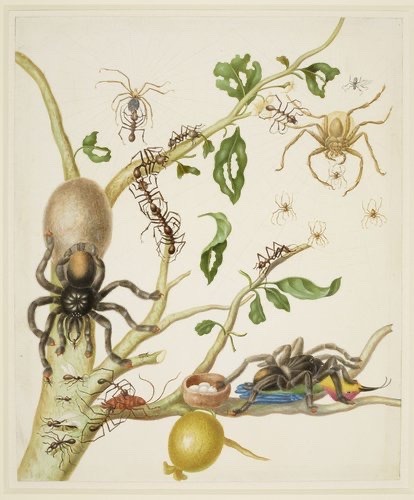

“In Quotes”
Maria Sibylla Merian, was a 17th century Naturalist who documented nature through watercolor sketches,that were often later made into drypoint etchings, for prints.
She is credited by many as being the person to discover metamorphosis, she also discovered many new species during her lifetime.
I was inspired by the informative scientific prints, which often depict plants and insects in various stages of their life cycles.
Aesthetically her work is really clean and provides a calming feeling even when drawing spiders... which can be tricky I imagine.
So my inspiration was to create photos in the likeness of her style, as well as being informative images that are pleasing to look at, regardless of potential bug phobias out there...
I feel like I learned a lot about staging scenes, with use of external light sources. I was also able to work in a relatively controlled manner, which brought out a lot more of my intentions in the prints I have presented.
1 note
·
View note
Photo
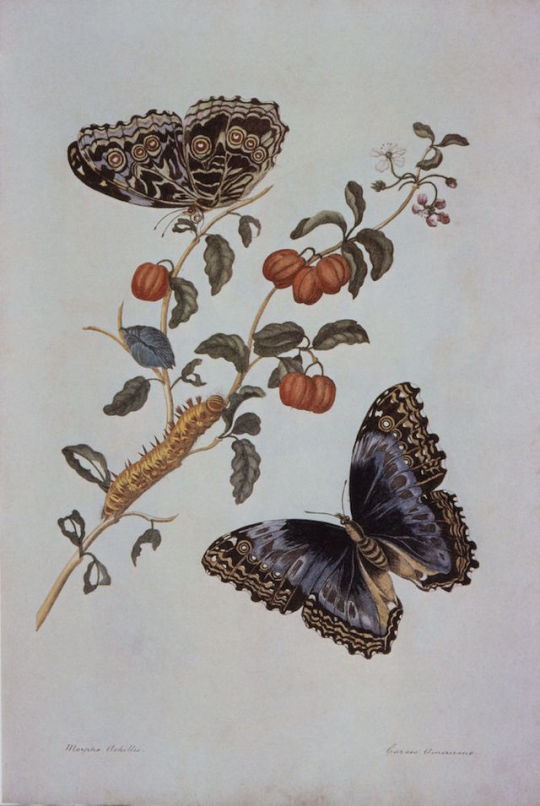
On this day, Maria Sibylla Merian was born in 1647.
Merian was a botanical artist, scientific illustrator and naturalist, born on April 2nd in 1647 to a descendant of the Swiss Merian family, founders of a large publishing house in the 17th century. Her favorite subject was insects. In 1705, she published her major work on documentation of the metamorphosis of the butterfly, and she became famous.
In its introduction, Merian wrote: "I spent my time investigating insects. At the beginning, I started with silk worms in my home town of Frankfurt. I realized that other caterpillars produced beautiful butterflies or moths, and that silkworms did the same. This led me to collect all the caterpillars I could find in order to see how they changed".[1]
We can only imagine her studio full of caterpillars!
Dissertatio de Generatione et Metamorphosibus Insectorum Surinamensium
Butterflies
prints
Merian, Maria Sibylla (1647-1717, Swiss), artist
1719
Swiss
[1] https://en.wikipedia.org/wiki/Maria_Sibylla_Merian
17 notes
·
View notes